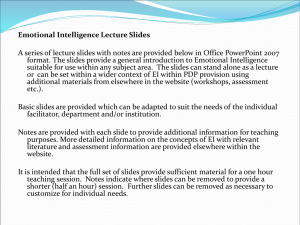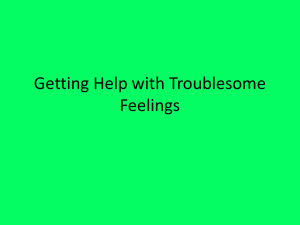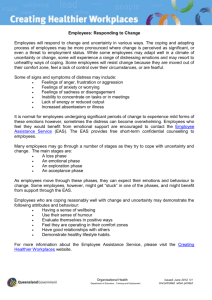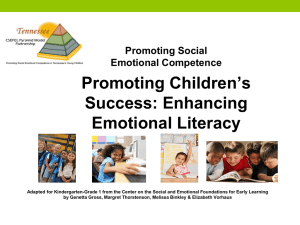Emotions Management Practical Strategies Handout 2015
advertisement
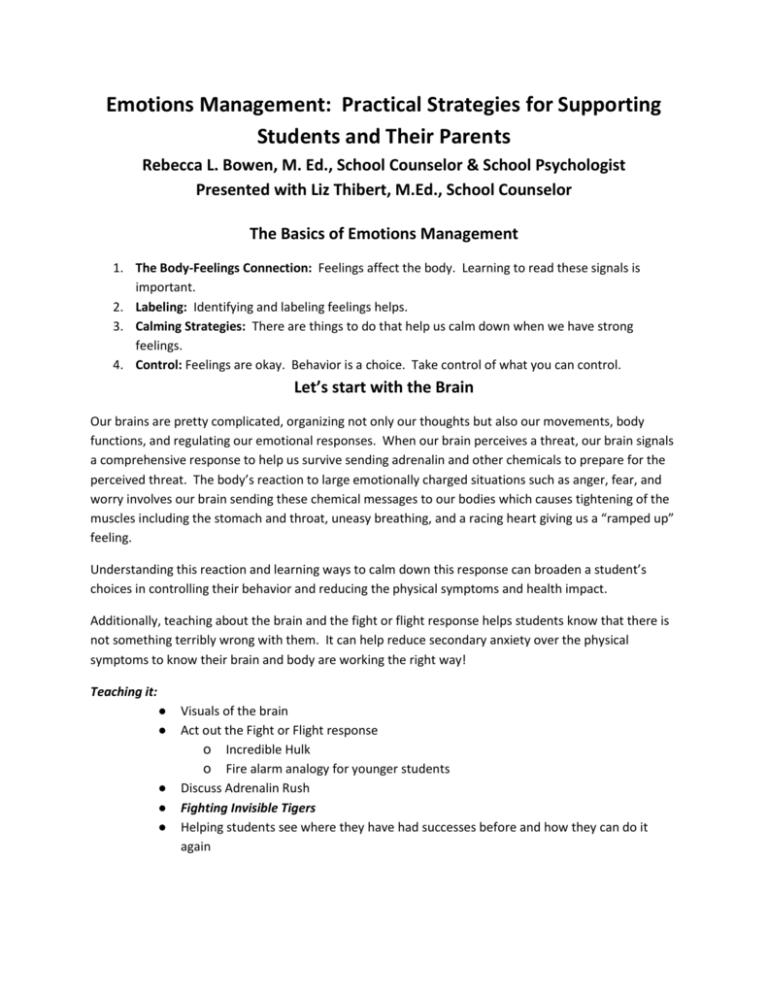
Emotions Management: Practical Strategies for Supporting Students and Their Parents Rebecca L. Bowen, M. Ed., School Counselor & School Psychologist Presented with Liz Thibert, M.Ed., School Counselor The Basics of Emotions Management 1. The Body-Feelings Connection: Feelings affect the body. Learning to read these signals is important. 2. Labeling: Identifying and labeling feelings helps. 3. Calming Strategies: There are things to do that help us calm down when we have strong feelings. 4. Control: Feelings are okay. Behavior is a choice. Take control of what you can control. Let’s start with the Brain Our brains are pretty complicated, organizing not only our thoughts but also our movements, body functions, and regulating our emotional responses. When our brain perceives a threat, our brain signals a comprehensive response to help us survive sending adrenalin and other chemicals to prepare for the perceived threat. The body’s reaction to large emotionally charged situations such as anger, fear, and worry involves our brain sending these chemical messages to our bodies which causes tightening of the muscles including the stomach and throat, uneasy breathing, and a racing heart giving us a “ramped up” feeling. Understanding this reaction and learning ways to calm down this response can broaden a student’s choices in controlling their behavior and reducing the physical symptoms and health impact. Additionally, teaching about the brain and the fight or flight response helps students know that there is not something terribly wrong with them. It can help reduce secondary anxiety over the physical symptoms to know their brain and body are working the right way! Teaching it: ● ● ● ● ● Visuals of the brain Act out the Fight or Flight response o Incredible Hulk o Fire alarm analogy for younger students Discuss Adrenalin Rush Fighting Invisible Tigers Helping students see where they have had successes before and how they can do it again Listening to our body It is really important to learn what our bodies are saying. If we pay attention, we can often take care of an emotional situation before it is complicated by poor behavioral choices or physical illness. ● ● ● ● ● ● ● ● ● Muscles tighten Messed up breathing Heart racing Shaky Headache Upset Stomach (butterflies) Heightened alertness Over arousal Sweaty palms ● Trouble Sleeping When we don’t address our body’s signals of ALERT! They tend to continue and build a nasty stomach ache, headache, or long term, cause ulcers, heart disease, and a host of illnesses. If you have a headache before a presentation that makes you feel anxious, it is not all in your head! Your body is reacting to the stress. Teaching students and their parents to recognize a stomach ache as a nervous reaction or a cue that the child might be anxious about something, empowers them to do something to address the emotion and slow down the body’s stress response. The Volcano effect: Similarly, if I recognize my body’s cues that I am getting angry and do something to manage my feelings when I sense the first rumblings, I won’t have to repair whatever destruction occurred with the explosion I may make if I let it build to the level of a volcanic eruption. If I take a break, go somewhere else, take a walk around the block or go to the gym to work it out, I can counteract the building anger response or keep it in check enough to maintain my problem solving capacity to figure out what else to do. Teaching it: ● Volcano visual ● Act it out (e.g., Show me what you look like when you are angry and point out body features.) ● Art: explore color and feelings based art representing feelings ● Books: Wemberly Worried by Kevin Henkes, When Sophie gets Really, Really, Angry by Molly Bang, The Way I Feel by Janan Cain, Sometimes I’m a Bombaloo by Rachel Vail, Wilma Jean and the Worry Machine by Julia Cook and Anita DuFalla, Howard B. Wigglebottom Learns it’s Okay to Back Away, by Howard Binkow. ● Body labeling (Safe Crossings body outline), outline of the child ● Reenactment of the situation; at the top of the circle, find out what the unwanted behavior was, work backwards to find out the triggers or emotions that were happening before the event. ● Self-care plan when calm to know exactly what to do when they are in a situation where they feel out of control. A note about School Anxiety: It is really hard for parents to send their kid to school if they have a stomach ache but when it is stress related, the best relief is to support the child with calming strategies to help them get on the other side of the stress mountain. Avoiding by not coming to school tends to allow more time for the anxiety to build and staying home creates further stress from missing the learning and social connections at school. It is important to teach this body-feeling connection to both the child and the parent, teach strategies to calm down, and instill confidence in the child’s ability to exercise some control of the symptoms. However, I have found that sometimes that is not enough. An important step for some students is an incentive for success. The rewards for being successful need to outweigh the gains of withdrawing. I have found success with point charts and positive incentive systems, which as always, require parental investment and consistency. Labeling feelings Identifying and labeling feelings helps. Learning to recognize, express, and talk about various feelings is an important life skill. When we have a strong emotion, it is very healing to have that feeling recognized, to feel understood, and to understand our own feelings. Somehow identifying it makes it feel a little less out of control. When we know what it is, we can do something about it. Labeling: Labeling feelings is not as straight forward as it seems. I suppose if we stick to the basics: Happy, Sad, and Mad, it is pretty easy. But most feelings have a more complicated recipe than that. Many times we have mixed feelings, multiple feelings at once or feelings that mask the real feelings down underneath. Anger is often this way. A child may be yelling and throwing a fit about something and look really angry, but it may be that he is protecting deeper feelings of guilt, hurt, shame or embarrassment. Go Deep: Uncovering the deeper emotions can lead to a much clearer understanding of our child’s feelings as well as provide insight into our own emotional world and labeling them can help start the process of calming down. Teaching it: ● ● ● ● ● ● Talk Blocks Feelings posters, pictures Second Step Poster Feelings charades Anger Iceberg Put it outside of the student and ask how their friend might have felt. After they have identified the feeling, bring it back to them. I can do something to help myself calm down (Strategies) Sometimes we feel really stuck in our feelings and it seems that we are powerless against them. Feelings can change! There are actually things I can do to change them! The first steps in calming down are to slow down the physiological response Teaching it: Deep Breathing: ● Teach basic cardiovascular and breathing mechanism with visuals. Shallow breathing deprives us of fresh oxygen, triggers alert response. ● Belly Breathing: Second Step video provides a great visual on belly breathing for elementary students. ● Blowing up a “balloon” ● “Smell the flower, blow out the candle” ● Pufferfish ● Hoberman’s sphere, “breathing ball” ● Jelly fish, breathing wands Muscle Relaxation: ● “Spaghetti arms and legs” ● Shake it off (like an athlete) ● Progressive relaxation ● Squeeze and release ● Yoga Positive Thoughts and Positive Self-Talk: The secret to success in staying calm is learning to use visualization, positive thoughts, and self-talk to change feelings. The same techniques work whether the emotion is anxiety or anger. As long as we keep rehearsing the worry or angry thoughts in our heads, we stay stuck in the feeling. When we ON PURPOSE take control over our mental thoughts and replace them with something positive and true, we can start to de-escalate. Feelings start to change. Types of positive thoughts to help calm down: ● Something I am looking forward to ● A good memory ● Favorite things ● Things I like to do ● Silly things that make me smile ● One good thing about my day ● Visualize my happy place ● Visualize a movie, book, or song in my head Self talk: I can do it, It will be alright, I don’t have to be perfect, I am safe, Hang in there, Don’t give them my power, stay in control, calm down, Chill, Relax. Teaching it: ● Visuals, signs and banners ● Dr. Playwell’s Positive Thinking Card Game ● Personal Self-Talk “Menu” ● Feelings wheel adapted to self-talk and happy thoughts Healthy Strategies to Calm Strong Feelings ● ● ● ● ● ● ● ● ● ● ● ● ● ● ● ● ● BREATH: Deep, relaxing breathing is one of the best ways to start shutting down a strong emotional response. RELAX MUSCLES: Pretend your arms and legs have turned into spaghetti noodles. Shake it off like you are next up to bat. Tighten your muscles then release while lying on the floor and doing your deep breathing. POSITIVE SELF TALK: Tell yourself, “calm down”, or “I can do this!” or think about positive things and block negative thinking. VISUALIZE: Take an imaginary trip to your HAPPY PLACE. Close your eyes, breathe deeply, and imagine yourself in a calm and wonderful place. EXERCISE: Run, jump, walk, dance. Physical exercise can help get rid of muscle tension and butterfly stomach. Movement causes our brains to send chemical messages to calm down when angry, scared, or worried. ALONE TIME: Find a quiet spot to be alone for a few minutes. It is easier to calm down when we are not in front of other people. TALK TO SOMEONE: Talk to a person you trust or someone who cares about you or a friend. A HUG: Get a hug from someone who cares about you. We can calm ourselves with deep pressure such as curling up in a heavy blanket, or hugging a pillow tightly. MUSIC: Listen to quiet music to calm down. Put on happy music to increase energy. Be careful with music makes you feel sad or angry. Music has the power to change our mood. JOURNAL WRITING: Write your thoughts and feelings down, it helps organize your emotions and experiences. Drawing journals can help too. LAUGH OR SPEND TIME WITH FRIENDS: Watch a funny movie or funny videos. Spend time with supportive friends that will help you cheer up. PLAY/BUILD/CREATE: Take a break to play, build with Legos, put a puzzle together, or create something. Using the creative part of our brain gives the emotions a rest. TURN OFF THE TV AND COMPUTER: Avoid information overload and manage exposure to media images and the NEWS during times of emotional difficulty. EAT HEALTHY: Avoid eating heavy junk food, sugar, and caffeine, during emotional times. These foods can make you feel cranky or jittery and sugar highs and lows can make emotions management more difficult. Take a break for a healthy snack or drink of water can have a calming effect. REST: Take a rest to regroup after strong feelings. SLEEP: Get plenty of sleep to help keep emotions in check. It is really hard to manage emotions when you are short on sleep. However, sleeping too much can become a problem if it’s a method of checking out instead of handling problems. ● MANAGE TIME: Be careful to avoid a too busy schedule. Plan ahead for down time. Older students can use a Day-Timer or student planner to keep track of assignments and commitments. Procrastination can cause major stress! Teaching it: ● ● ● ● ● Calming card/strategy charades o Act it out o Tell when you would use the strategy Personal Menu Calming Wheel Self-soothing box Safe place to go either with visualization (beach) or physical location Empowering with CHOICE The first teaching point is more of an approach than a method but it is very important to de-stigmatize emotions. Everybody has them, they aren’t bad or good, YOU aren’t bad or good if you feel a certain way. They might be comfortable and uncomfortable but not right or wrong. It’s okay to be angry…it’s what we do when we have a feeling that is sometimes a problem. Behavior is a choice. Teaching it: ● Posters, pictures, words, signs ● Working in groups shows that everybody has feelings, it’s not just me. ● Choice activities o Wilma Jean and the Worry Machine by Julia Cook and Anita DuFalla o Things I can Choose/Things I cannot Choose T chart ● One on one empowering conversations for students that might not hear it anywhere else ● Family reflection sheets that allow them to see how people in their family deal with stress, anger, and hurt. This can be a stepping stone to taking control of their own feelings. Conclusion: As School Counselors we can play a critical role in developing skills students need to manage their emotions in healthy ways. By equipping parents with strategies to support their children this learning has the potential to impact their whole lives. Reaching Parents: ● Parent Classes ● Newsletter articles ● Counseling Website ● Handouts on relevant topics ● Referral information ● Summaries and home links from curricula and group work ● Committee for Children website When to refer for professional Help: ● When a parent feels they are not able to be safe with their child ● When there has been abuse ● When you suspect issues with eating disorders ● When children are engaging in self harm or other self destructive behaviors ● When a child speaks of suicide, loss of hope, or wanting to die ● When grief is complicated or child does not progress toward a return to normal emotions ● When you suspect psychological disorders ● When there has been traumatic experiences ● When there are dramatic changes in mood or behaviors ● If you suspect drugs, alcohol or other high risk behaviors References: ● ● ● ● ● ● Emotion Coaching, The Heart of Parenting, John Gottman, Ph.D. and Julie Schwartz Gottman, Ph.D. Raising an Emotionally Intelligent Child, John Gottman, Ph.D. and Joan DeClaire Fighting Invisible Tigers, Earl Hipp Second Step Curriculum, Committee for Children http://www.cfchildren.org/programs/ssp/overview When Panic Attacks, David D. Burns, M.D. Feeling Good, David D. Burns, M.D. Equipping Parents through Emotion Coaching (Based on the writings of Dr. John Gottman) Raising an Emotionally Intelligent Child Emotion Coaching, the Heart of Parenting DVD series Compiled by Liz Thibert, School Counselor Emotions Coaching, researched by the Gottman Institute, is a process by which parents can connect with their children by helping them to label and understand their emotions to create problem solving solutions for their needs. 1. Emotions coaching key a. Getting involved with your childs emotions teaching them how to deal with life's up and downs b. Teaching emotional intelligence c. Children who have been Emotion Coached sustain favorable effects i. These children get along better with friends, experience fewer negative negative feelings and more positive feelings, and are more emotionally healthy. d. Reduce child risk i. Fewer behavior problems, less prone to act of violence, better physical health, and score higher academically. e. Children use it for an evaluative tool for their own thinking (self-regulation) 2. Assessing your parenting style - self-test located in the book a. Dismissive parent i. Child's feelings are trivial ii. Wants negative emotions to disappear iii. Uses distraction iv. Makes light of emotions v. Fears being out of control emotionally vi. Believes bad behavior reflects on them vii. Does not problem solve viii. Effect: child learns that their emotions are not important and may have a hard time controlling them. They learn that there is something inherently wrong with them because of their feelings. b. Disapproving parent i. Judges and criticizes emotional expression ii. Over aware of the need to set limits iii. Reprimands emotional expression iv. Believes child uses negative emotion to manipulate v. Believes negative emotions as a commodity that should not be squandered vi. Emotional people are weak vii. Effect: Same as dismissive parent c. Laissez-Faire parents i. Freely accepts all emotions ii. Offers comfort iii. Offers little guidance on behavior iv. Does not teach about emotion v. Does not set limits vi. Does not teach problem solving vii. Believes there is little to do about negative emotions than ride them out, releasing them is key viii. Effect: kids don't learn to regulate their emotions, trouble concentrating, forming friendships and getting along with others d. Emotions Coach i. Values negative emotions as a chance for intimacy ii. Can tolerate spending time with sad, angry, fearful child iii. Aware of their own values iv. Sensitive to their child's emotional state v. Respects childs emotions vi. Doesn't poke fun of the negative emotions vii. Doesn't feel like they need to fix the child viii. Takes time to: listen, empathize, help, offer guidance, set limits, teach ix. Effects: kids learn to trust their feelings, regulate own emotions, solve problems, and have high self esteem and get along with others e. 5 key steps for emotions coaching i. Be aware of the child's emotions ii. Recognizing the emotion as an opportunity for intimacy and teaching iii. Listening empathetically and validating the child's feelings iv. Helping the child verbally label emotions v. Setting limits while helping the child problem solve 1. identify goals 2. think of possible solutions with your child 3. evaluate proposed solutions based on your family values 4. help your child choose a solution f. Emotion coaching strategies i. Avoid excessive criticism, humiliating comments, or mocking ii. Use scaffolding (only as much as the child can handle) and praise to coach your child iii. Ignore you parental agenda iv. Create a mental map of your child’s daily life v. Avoid “siding with the enemy” (with the negative person, event to prove a point) vi. Think about your child’s experience in terms of similar adult situations vii. Don’t try to impose your solutions on your child’s problems viii. Empower your child by giving choices, respecting wishes ix. Share your child’s dreams and fantasies x. Be honest with your child xi. Read children’s literature together xii. Be patient with the process xiii. Understand your base of power as a parent xiv. Believe in the positive nature of human development g. When Emotions Coaching is not appropriate i. When you’re pressed for time ii. When you have an audience iii. When you are too upset or too tired for coaching to be productive iv. When you need to address serious misbehavior v. When your child is “faking” an emotion to manipulate you vi. When you decide to postpone emotions coaching, make a promise to you and your child that you will go back to the issue soon. Emotions Coaching Conclusion Emotions Coaching is a way to connect with your child to create a lifelong set of strategies so they can lead emotionally healthy lives. This is a proven technique that will change the relationship you have with your kids, spouse, and other relationships. It puts what matters most at the center to find solutions with respect and dignity. We have all the skills we need to be an Emotion Coach but just need to take the extra time to implement it. It won’t be a waste! Reaching Parents: Raising an Emotionally Intelligent Child, by John Gottman, Ph.D. Emotions Coaching DVD series by the Gottman Institute.



